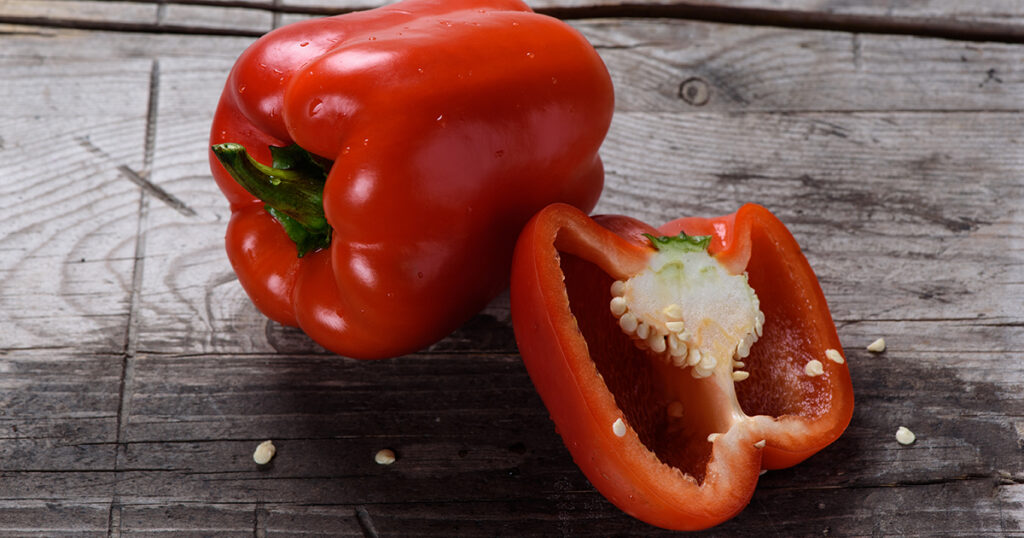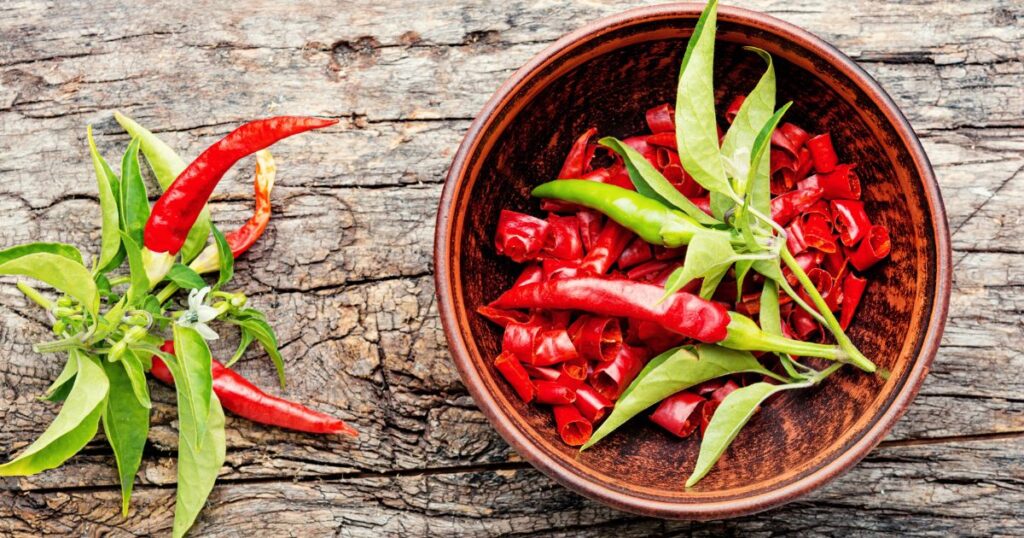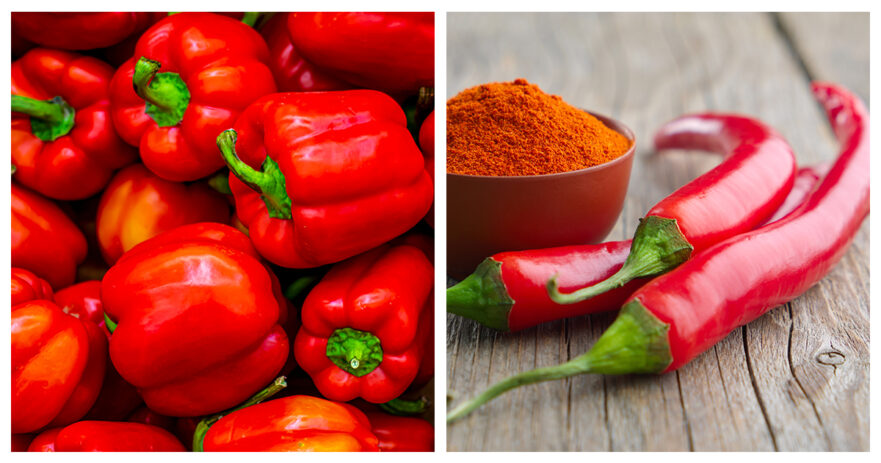A dash of the right pepper can sometimes distinguish between an “okay” dish and an “oh wow” dish. If you’ve ever stood in the produce section, you’ve probably had to choose between red and cayenne peppers. While they are members of the same pepper family, their flavors, applications, and heat profiles are as varied as the foods they spice up. So, let’s look at what distinguishes these two popular peppers.
Table of contents
What Is Red Pepper?

When we talk about red peppers, we usually mean bell peppers, which come in various colors, including red. These peppers are versatile culinary stars known for their sweet, mild flavor. The red bell pepper can be used in various dishes, including fajitas, ratatouille, salads, and stuffed peppers. They are delicious raw, sautéed, roasted, or blended into smoothies and pasta sauces.
Because of their natural sweetness, they pair well with savory and slightly sweet dishes, providing chefs and home cooks with a versatile canvas for their culinary creations. Red bell peppers have no heat on the Scoville scale, so they are all flavor and no fire.
They originated in Mexico, Central, and South America but have since become a global staple grown in gardens and farms worldwide. They not only add a splash of color to any dish but are also an excellent source of vitamins and nutrients.v
They’re especially high in vitamin C, fiber, and antioxidants like beta-carotene. Because of their low-calorie content, they are an excellent choice for anyone watching their waistline, providing a nourishing yet flavorful addition to your meals. So, the next time you cook, remember that the red pepper is more than just a pretty face—it’s a nutritional powerhouse that can improve your dish’s taste and health benefits.
What Is Cayenne Pepper?

Moving on to cayenne pepper, this pepper packs a punch when it comes to heat. Cayenne peppers, which have a Scoville rating ranging from 30,000 to 50,000, are frequently dried and ground into a fiery red powder used in many cuisines, particularly spicy dishes. The fresh pepper is long, skinny, and red, with a strong heat. Cayenne pepper, which was originally native to the tropical regions of Central and South America, has become a global phenomenon, being grown in gardens and commercial farms all over the world.
Cayenne pepper is frequently used to season dishes like chili, soups, and stews, bringing its signature heat to a variety of culinary creations. It’s also a common ingredient in various hot sauces, where its intense heat helps elevate the flavors of various dishes. The capsaicin that gives cayenne its fiery flavor has been shown to improve metabolism and act as a natural preservative, keeping food spicy and fresh.
Cayenne peppers prefer sunny, well-drained conditions when growing. They thrive in both traditional gardens and pots, making them a viable option for those wanting to grow their own spices. Cayenne peppers adapt well to various growing conditions, whether on a balcony or in a large field.
Cayenne peppers, like red bell peppers, have gone global. Their vibrant red color and intense heat make them a memorable addition to any dish, while their adaptability makes them a viable option for both home gardeners and commercial growers. So, the next time you’re spicing up a dish, remember that cayenne is more than just a hot pepper; it’s a global culinary staple with numerous applications.
Similarities between Red Pepper and Cayenne Pepper
Although the heat and flavor of red and cayenne peppers differ, they share some similarities. Because they are both members of the Capsicum family, they have similar nutritional benefits, such as being high in vitamin C. As a result, they are an excellent choice for those looking to strengthen their immune system through diet.
Another thing they have in common is their culinary versatility. Both types of peppers can shine in a hot sauce or a bell pepper salad. They’re fantastic for adding color and flavor to a variety of dishes, making them a must-have in any home cook’s arsenal. Chefs frequently use them to add that extra zing or splash of color that elevates a dish from good to great.
Furthermore, these peppers thrive in hot, sunny climates and are relatively simple to grow at home, especially if you have a sunny window or backyard garden. Both varieties provide rewarding yields with minimal effort for gardeners. Because of their hardiness, they are suitable even for inexperienced gardeners, making it simple for anyone to grow their own fresh peppers.
Finally, red and cayenne peppers are popular worldwide. These two types of peppers have found their way into the hearts and recipes of people worldwide, from spicy cayenne pepper wings in the southern United States to stuffed bell peppers in Mediterranean cuisine. They’ve gone beyond regional cuisine, finding a home in kitchens and dishes all over the world.
Differences between Red Pepper and Cayenne Pepper
Let us now look at what distinguishes them. First and foremost, the heat level: red peppers are sweet and mild, whereas cayenne peppers are hot and spicy. Cayenne pepper should be avoided if you are sensitive to heat.
Second, their physical appearances could not be more dissimilar. Red peppers are typically round, plump, and large, ranging from four to six inches long. On the other hand, Cayenne peppers are slender, elongated, and smaller, ranging in size from two to five inches. Because of the stark differences in shape and size, each is best suited for specific culinary applications, enhancing their distinct roles in the kitchen.
Third, how these peppers are consumed distinguishes them. Fresh red peppers are popular, frequently appearing in salads, stir-fries, and edible bowls for stuffed pepper recipes. Their crisp texture and bright flavor stand out, especially when fresh. On the other hand, Cayenne peppers are typically dried and ground into a fine powder and are primarily used as a spice in various recipes. Their dried form enables more precise seasoning and a concentrated burst of heat.
Finally, each pepper has its own set of nutritional benefits. While both are high in vitamins, cayenne contains capsaicin, a compound known to increase metabolism and promote fat loss. On the other hand, red peppers lack this compound but are high in vitamin C and other antioxidants, making them both flavorful and nutritious.
FAQ about Red Pepper and Cayenne Pepper
How spicy is cayenne compared to red pepper?
Cayenne pepper is significantly hotter than red bell pepper. Cayenne pepper has a Scoville heat rating of 30,000 to 50,000, whereas red bell peppers have a heat rating of zero. Because of the stark difference in spiciness, they are suitable for a variety of culinary applications.
How do you store red pepper and cayenne peppers?
Red and cayenne peppers should be stored in a cool, dry place to keep their freshness and flavor. For maximum longevity, store fresh red peppers in the vegetable crisper section of your refrigerator. On the other hand, dried cayenne pepper powder should be stored in an airtight container in a dark cabinet to maintain its spiciness.
Can I substitute one for the other?
It all depends on how daring you want to be. Because they have different heat profiles, substituting one for the other will drastically alter your dish. Use red for mildness and cayenne pepper for heat.
What are some popular dishes for each?
Stuffed peppers, stir-fries, fajitas, salads, and ratatouille are all popular uses for red peppers. Because of their mild, sweet flavor, they are a versatile ingredient in a wide variety of recipes. On the other hand, Cayenne is the star in dishes that crave heat, such as spicy hot wings and Cajun-inspired gumbo. It's also used in unusual desserts like spicy chocolate cakes, where it adds a kick to balance out the sweetness.

